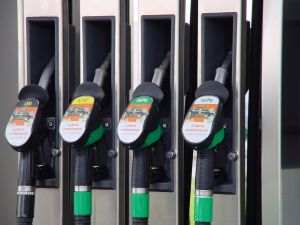Making Smarter Choice at the Pump: Biofuel facts for the road
 Despite great efforts to reduce our carbon footprint, many of us still drive vehicles on a near-daily basis. To negate the environmental impacts of gasoline, some carpool or take transit, while others have been fortunate enough to find their way into an electric car or a micro-hybrid (stop-start cars, so named because their combustion engines turn off when the car stops, say at a red light).
Despite great efforts to reduce our carbon footprint, many of us still drive vehicles on a near-daily basis. To negate the environmental impacts of gasoline, some carpool or take transit, while others have been fortunate enough to find their way into an electric car or a micro-hybrid (stop-start cars, so named because their combustion engines turn off when the car stops, say at a red light).
Nevertheless, statistics from the US Environmental Protection Agency (EPA) show that motor vehicles (including non-road vehicles), account for some 75% of carbon monoxide emissions nationwide. Clearly, Americans aren’t doing enough to reduce vehicle-related pollutants.
Ongoing efforts have been made in some regions of the United States, however, to increase the availability of biofuels (liquid fuels that are derived from renewable sources, such as from plants or vegetable oils). Last year, for example, the I-75 Green Corridor project was completed in the eastern US, and currently represents the nation’s longest biofuels corridor via a six-state partnership.
Interstate 75 runs from Sault Ste. Marie, Michigan at the Canadian border to Miami, Florida. Biofuels stations were added with the intent of filling in gaps in access along the interstate, such that a station of each type can now be found no greater than 200 miles apart. Five years in the making, the I-75 Green Corridor Project’s goal was to enable travel along the entire 1,786 mile-length of this highway, using either of the two primary biofuels: E85 or B20.
Using E85 requires a flex-fuel vehicle (FFV), while many diesel vehicles can use B20. FFV’s are engineered to run on gasoline, or any blend of up to 85% ethanol. Whereas, almost all diesel vehicles can run on biodiesel (B20), with few if any modifications to the vehicle—though it’s always important to properly verify compatibility with the manufacturer.
As the options at gas stations increase, it’s not uncommon for drivers to be unclear of what to choose when it comes to the different biodiesel names and numbers. From E10 and E85 to B20, the Energy Department’s Bioenergy Technologies Office (BETO) recently compiled some basic definitions and information to make fueling up a simpler—and, hopefully, a greener—choice for those on the road.
Finding clarity in biofuels
Investing in ongoing research and development (R&D) to help commercialize biofuels, BETO is working to make other second-generation biofuel options available in an effort: “To reduce America’s dependence on foreign oil, build the economy, and reduce greenhouse gas emissions (according to their website).
For now, here’s a quick breakdown of the cleaner fuel options available at many gas stations across the US*…
· E10
Though the wording many vary, look for “Contains 10% ethanol” on the gas pump. According to BETO, this label means that ethanol has been blended into the petroleum gasoline—resulting in a combined 10% ethanol and 90% petroleum gasoline. Ethanol is an alcohol-based fuel, made from plant materials that have a high-octane rating. It burns cleaner than petroleum.
Ethanol must be blended with petroleum fuel to be used in conventional cars and trucks. Blends of up to 10% ethanol (E10) are approved for use in all vehicles, as well as in all gasoline transportation, storage, and dispensing infrastructure in the US. E10 is now sold in every state.
· E85
When “E85” is at the pump, it’s usually marked in yellow. Not as widely available as E10, E85 denotes gasoline that offers up to 85% ethanol. And, unlike E10, E85 requires a FFV. As mentioned, flex-fuel vehicles are designed to run on gasoline, or any blend of up to 85% ethanol. In some areas, blend pumps even allow drivers a choice in terms of the percentage of the ethanol included. (If unsure of your vehicle’s FFV status, simply search the online list of E85 vehicles by type and model year. The CleanFuelsCorridor.com also has information at www.cleanfuelscorridor.com/findvehicles.html).
Interesting, BETO has started working with the Energy Efficiency and Renewable Energy’s (EERE) Vehicle Technologies Office and the National Renewable Energy Laboratory (NREL) on a preliminary investigation of E20–E40 ethanol blends (20% to 40% ethanol) in advanced engines, which could be developed to better utilize high-octane fuel. The greater fuel efficiency from higher-octane levels could offset ethanol’s lower energy content compared to petroleum gasoline.
· B20/Biodiesel
Those with a diesel engine can also purchase a biodiesel blend-fuel at many fueling stations. According to BETO, its properties are similar to petroleum diesel, but it comes from renewable resources and emits fewer pollutants. In this case, diesel engines don’t need to be modified to use it, and engines usually run better with a biodiesel blend—most commonly at 20%.
Most biodiesel is produced from vegetable oils, animal fats, and recycled restaurant grease, and is already available on the commercial market. In the future, renewable diesel could be produced from other bioenergy feedstocks, such as algae and woody crops. The DOE maintains that compared to biodiesel, renewable diesel has lower greenhouse gas emissions, can be made from non-food based oils, and is chemically identical to petroleum diesel.
The future of biofuels
Looking ahead, the Energy Department’s Bioenergy Technologies Office is focused on the R&D of “drop-in” hydrocarbon biofuels, including algae-based fuels. Rather than being “blended-in,” like the other cleaner fuel options, drop-in biofuels could be used as a direct replacement for petroleum fuel in conventional cars.
The goal is to validate a modeled price of $3 per gasoline gallon equivalent for this fuel by 2017. According to the DOE, National laboratories, university researchers, and pilot and demonstration facilities across the country are working to make the conversion process and supply chain cost-competitive with petroleum fuel.
* Read the full Department of Energy’s Bioenergy Technologies Office release, entitled “Biofuel Facts for the Road: The Energy Department and Your Gasoline Pump” at http://energy.gov/eere/articles/biofuel-facts-road-energy-department-and-your-gasoline-pump
Department of Energy’s Bioenergy Technologies Office (BETO)
www.energy.gov
I-75 Green Corridor Project
www.cleanfuelscorridor.com
Volume: January/February 2015











